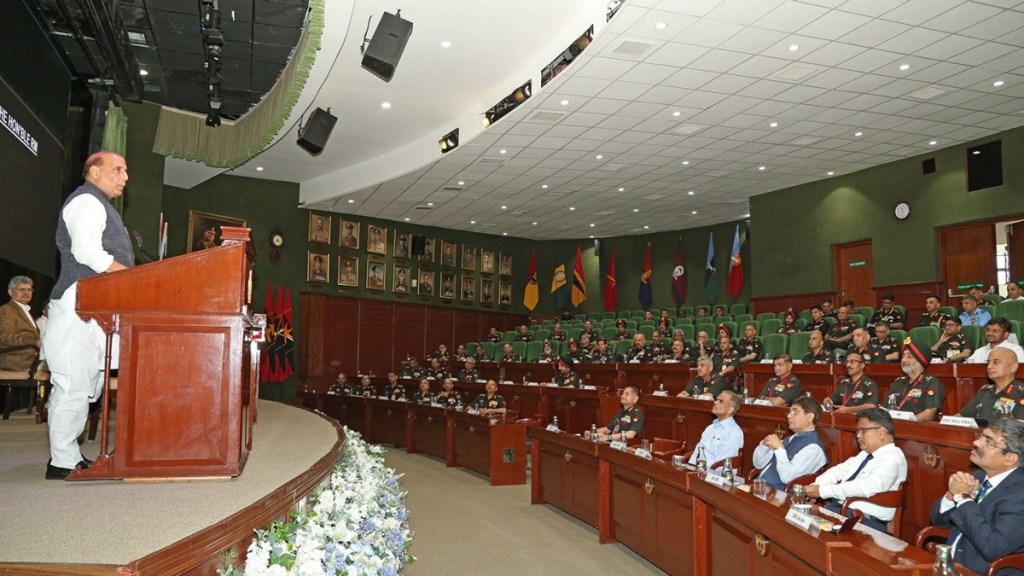The recent Army Commanders’ Conference held in New Delhi provided a platform for senior leadership to delve into a wide array of security-related aspects and future strategies.
With a focus on leveraging technology, enhancing operational preparedness, and addressing emerging security challenges, the conference yielded several key takeaways that underscore the Indian Army’s commitment to modernization and readiness.
Defence Minister Rajnath Singh, in his keynote address on April 2, 2024, reaffirmed the nation’s trust in the Indian Army, acknowledging its indispensable role in national security. He applauded the stellar role of the Army in guarding the borders, fighting terrorism and providing aid to the civil administration during crises. The minister urged the Army leadership to constantly review doctrinal, structural, & organisational reforms to meet future challenges in view of the evolving security dynamics.
The defence minister also appreciated the efforts of Indian Army in developing niche technologies in collaboration with indigenous industries and premier educational institutions.
One of the central themes of the conference was the imperative to embrace technological advancements. The senior leadership emphasized the importance of integrating niche technologies into the Army’s capabilities to ensure readiness for future challenges. This includes organizational and procedural transformations aimed at facilitating the adoption of innovative solutions.

Upscaling the innovation potential of the Army Design Bureau and establishing Army Design Bureau Cells at Command Headquarters were identified as crucial steps to foster collaboration with industry partners and expedite the identification and trials of niche technology.
Furthermore, the conference highlighted the need to strengthen capability development efforts in line with the national agenda of self-reliance (‘Atmanirbharta’). The creation of a separate fund head to streamline procurement processes and ensure the seamless integration of niche technologies into the Army’s arsenal was proposed. Additionally, the nomination of test bed brigades/formations aims to enhance efficiency in trials and procurement processes, ensuring the timely acquisition of cutting-edge equipment.
Collaboration and resource optimization emerged as another key focus area. The Indian Army intends to explore more opportunities for collaboration with other ministries to maximize resources and synergize efforts. This collaborative approach seeks to enhance capability building and infrastructure development in border areas, thereby bolstering national security.
Human resource management was also a prominent topic of discussion at the conference. Recognizing the pivotal role of human capital in driving technological advancements, the conference emphasized the need to revise HR policies. These revisions will focus on facilitating the absorption of niche technology through enhanced training infrastructure and innovative policies, ensuring that the workforce is well-equipped to navigate the complexities of modern warfare.
In addition to technological advancements and human resource development, the conference underscored the importance of realistic training scenarios. Ensuring realistic training is vital for preparedness in modern warfare. To this end, the feasibility of creating a tailor-made organization to serve as an adversarial force during wargames and training exercises was discussed. This initiative aims to enhance the Army’s readiness by simulating real-world scenarios and challenges, thereby honing the skills of its personnel and ensuring optimal operational effectiveness.
The senior leadership of the Army was also addressed by General Anil Chauhan, Chief of Defence Staff (CDS), General Manoj Pande, COAS, Admiral R Hari Kumar, Chief of the Naval Staff (CNS) and Air Chief Marshal VR Chaudhari, Chief of the Air Staff (CAS).
The CDS praised formations and the soldiers for their commitment towards security of the borders with a professional approach while at the same time dealing with challenges and embracing the transformational changes enthusiastically.
The COAS Gen Manoj Pande called upon the senior leadership to continue pursuing the process of transformation and technology absorption besides adopting the best practices of sister services and modern armies. He also highlighted the need to ensure seamless situational awareness between commanders at all levels and troops on the ground. The Army Chief also emphasized that there is a constant need to undertake doctrinal and structural reforms by embracing change and being open to new ideas to meet future operational challenges.
Overall, the Army Commanders’ Conference provided a platform for strategic deliberations and forward-thinking initiatives aimed at bolstering the Indian Army’s capabilities in an evolving security landscape. By prioritizing technological innovation, collaboration, and human resource development, the Indian Army is poised to meet the challenges of the future while upholding its commitment to national security and self-reliance.


